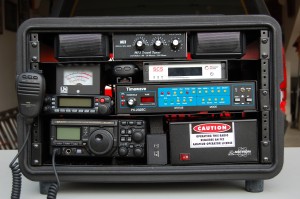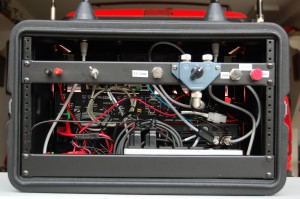Wilson Co. NC Auxiliary Emergency Communications Go Kit
Being prepared for an emergency communication deployment involves a wide range of considerations, including radio equipment, power sources, clothing and personal gear, food and water, information, and specialized training.
The last thing you should need to do when a call for assistance comes is think of and locate all the items you might need. Any experienced emergency responder knows how important it is to keep a kit of the items they need ready to go at a moment’s notice. This is often called a “jump kit” or “go kit.”
Without a jump kit, you will almost certainly leave something important at home, or bring items that will not do the job. Gathering and packing your equipment at the last moment also wastes precious time. It is important to think through each probable deployment ahead of time, and the range of situations you might encounter. Here are a few basic questions you will need to answer:
- Which networks will you need to join, and which equipment will you need to do so?
- Will you need to be able to relocate quickly, or can you bring a ton of gear?
- Will you be on foot, or near your vehicle?
- Is your assignment at a fixed location or will you be mobile?
- How long might you be deployed – less than 48 hours, up to 72 hours, or even a week or more?
- Will you be in a building with reliable power and working toilets, or in a tent away from civilization?
- What sort of weather or other conditions might be encountered?
- Where will food and water come from? Are sanitary facilities available?
- Will there be a place to sleep?
- Do you need to plan for a wide variety of possible scenarios, or only a few?
- Can some items do “double duty” to save space and weight?
Most people seem to divide jump kits into two categories: one for deployments under 24 hours, and one for up to 72 hours. For deployments longer than 72 hours, many people will just add more of the items that they will use up, such as clothing, food, water, and batteries. Others may add a greater range of communication options and backup equipment as well.
Communications Equipment
- Handheld VHF or dual-band radio (some people also like to bring a spare)
- Spare rechargeable batteries for handhelds
- Alkaline battery pack or small gel-cell batteries for handhelds
- Alkaline batteries
- Speaker mic and earphone for handhelds
- Chargers, AC and DC for handhelds
- Mobile VHF or VHF/UHF dual-band radio
- VHF/UHF gain antennas and adapters (roll-up J-Pole, 6 ft. PVC support pipe, mobile magnetic mount, etc.)
- HF radio
- Multi-band HF antenna and tuner
- Coaxial feed lines, jumpers
- Ground rod, pipe clamp, and wire
- AC power supplies for VHF/UHF mobile and HF radios and accessories
- Large battery source (e.g. deep cycle marine) for VHF/UHF mobile and HF radios, with charger
- All related power, data, audio, and RF cables and adapters
- Small repair kit: multi-tool or hand tools, duct tape, electrical tape, multi-meter, connectors, adapters, fuses, key parts
- Materials for improvisation: wire, connectors, small parts, insulators, heavy parachute cord or nylon mason’s twine, etc.
- Photocopies of manuals, cheat sheets, or mini manuals for all equipment
- Headphones, for noisy areas and privacy with proper connector, adaptors
- Specialized gear for packet, ATV or other modes
- Personal cell phone, pager, spare batteries and chargers
- FRS or GMRS radios
- Multi-band scanner, weather radio
- Portable broadcast AM/FM radio
Personal Gear
- Clothing for the season, weather, and length of deployment
- Foul weather or protective gear, warm coats, hats, umbrella, etc. as needed
- First aid kit, personal medications and prescriptions for up to one week
- Toiletries kit: soap and shampoo, razor, deodorant, hair-brush/comb, toilet paper, hand wipes, hand sanitizer, toothbrush, toothpaste, towel
- Sunscreen and insect repellant
- Money, including a large quantity of quarters for vending machines, tolls, etc.
- Telephone calling card
- Water containers, filled before departure
- Coffee and/or tea bags
- High energy snacks
- Easily prepared dried foods that will store for long periods (e.g. MREs or canned food)
- Eating and cooking equipment if needed
- Large trashbags (use for rain/wind protection, as a container, or makeshift poncho)
- Flashlight or headlamp
- Lantern
- Waterproof matches, lighter, and/or fire starter
- Tent (ground cloth and rain fly)
- Tarp
- Sleeping bag, closed-cell foam pad, pillow, ear plugs
- Camp or folding chair
Information
- ID cards and other authorizations
- Copy of Amateur Radio license
- AUXCOMM Field Resource Manual
- Net schedules. Frequencies most used.
- Maps, both street and topographic (optional compass or GPS unit)
- Key phone numbers, email and internet addresses
- Contact information for other members in your group, AEC, DAEC, and others
- Copy of emergency plans
- Resource lists: who to call for which kinds of problems
Operating Supplies
- Pens, pencils, permanent marker, pencil sharpener (could use pocket knife or multi-tool)
- ICS FORMS
- Log sheets or books
- Standard forms used by the served agency
- Letter or legal size notepads
- Sticky notes
- Paper clips and rubber bands



